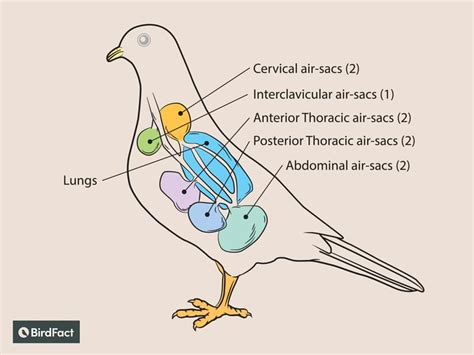Birds are beautiful, captivating creatures that bring joy to our lives. However, like all living things, they can be susceptible to various health issues, including respiratory ailments. Respiratory health is paramount for a bird’s well-being, and as responsible bird owners, it’s crucial to understand the importance of proper care and management to prevent and treat respiratory problems effectively.

The Importance of Respiratory Health
The respiratory system enables birds to exchange gases, providing oxygen to their bodies and expelling carbon dioxide. Its proper functioning is essential for maintaining optimal physical and cognitive health. Respiratory ailments can compromise this vital function, leading to severe health consequences, discomfort, and even mortality.
Common Respiratory Diseases in Birds
-
Aspergillosis: A fungal infection that affects the respiratory system, primarily caused by the Aspergillus fungus. It can lead to severe lung damage, breathing difficulties, and even death.
-
Avian Influenza (Bird Flu): A highly contagious viral infection that affects the respiratory and digestive systems of birds. It can cause coughing, sneezing, and difficulty breathing and can be fatal in some cases.
-
Ornithosis (Chlamydiosis): A bacterial infection that affects the respiratory system and can spread to humans through contact with infected birds or their droppings. It can cause discharge from the eyes and nose, coughing, and difficulty breathing.
-
Mycoplasmosis: A bacterial infection that affects the respiratory system and can cause coughing, sneezing, and wheezing. It can also lead to chronic respiratory problems if left untreated.
Symptoms of Respiratory Distress in Birds
Recognizing the signs of respiratory distress is crucial for early intervention. Common symptoms include:
- Labored breathing (open-mouthed breathing, tail bobbing)
- Sneezing or coughing
- Wheezing or whistling sounds
- Discharge from the eyes or nose (clear, cloudy, or colored)
- Loss of appetite or weight
- Lethargy or depression
Preventive Care and Management
Proactive measures are key to maintaining respiratory health in birds. Here are some essential preventive strategies:
-
Provide a Clean and Hygienic Environment: Regular cleaning and disinfection of cages, perches, and feeding and water bowls is essential to reduce the risk of infection. Ensure adequate ventilation to promote fresh air circulation.
-
Proper Nutrition: A balanced diet rich in essential vitamins and minerals is crucial for immune system support and optimal respiratory health. Fresh fruits and vegetables, quality pellets, and clean water should be provided daily.
-
Quarantine New Birds: Introducing new birds to an existing flock without proper quarantine can spread diseases. Isolate new birds for at least 30 days to monitor for signs of respiratory or other health issues.
-
Regular Veterinary Checkups: Establishing a relationship with an experienced avian veterinarian is vital for preventive care. Regular checkups provide an opportunity for early detection and timely treatment of respiratory ailments.
Treatment of Respiratory Infections
If a bird exhibits signs of respiratory distress, seeking prompt professional care is crucial. Your veterinarian may recommend one or more of the following treatments:
-
Antibiotics or Antifungals: To combat bacterial or fungal infections responsible for respiratory distress.
-
Nebulization: Administration of medicated aerosols to directly deliver medication to the respiratory system.
-
Oxygen Therapy: Supplemental oxygen may be necessary in severe cases of respiratory distress to support breathing.
-
Hospitalization: In critical cases, intensive care and monitoring may be required to stabilize the bird’s condition and provide ongoing treatment.
Future Trends and Innovations
Research and technological advancements continue to shape the field of respiratory health in birds. Key future trends include:
-
Precision Medicine: Tailoring treatments to the specific needs of individual birds based on their genetic makeup and unique characteristics.
-
Nanoparticle Technology: Developing innovative methods for targeted drug delivery to the respiratory system.
-
Artificial Intelligence: Utilizing AI algorithms to analyze data and improve diagnostic accuracy and personalized treatment plans.
Conclusion
Respiratory health is a cornerstone of a bird’s well-being. By understanding the importance of preventive care, managing risk factors, and seeking prompt veterinary attention when necessary, bird owners can help their feathered companions live long, healthy, and fulfilling lives. As the field of avian respiratory health continues to evolve, we can expect even more effective and innovative approaches to ensure the well-being of our beloved birds.
1. Can all respiratory infections in birds be cured?
Not all respiratory infections in birds can be cured. However, prompt diagnosis and treatment can significantly improve the chances of recovery and prevent complications.
2. How can I tell if my bird is wheezing?
Wheezing is a whistling sound that occurs during breathing, indicating narrowed airways. Listen closely to your bird’s呼吸声音 to detect any unusual or high-pitched sounds.
3. Should I isolate my bird if it shows signs of respiratory distress?
Yes, it is crucial to isolate any bird showing signs of respiratory distress to prevent the spread of potential infections to other birds.
4. What is the typical mortality rate for birds with respiratory infections?
The mortality rate for birds with respiratory infections varies depending on the type of infection, the severity of the case, and the timeliness of treatment. Early diagnosis and intervention can significantly reduce mortality rates.





















